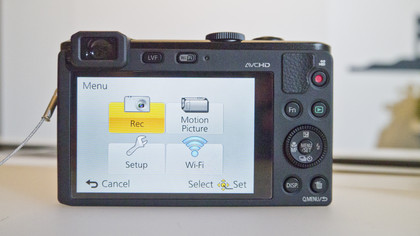Why you can trust TechRadar
Having been impressed with the performance of Panasonic Lumix compacts before, especially those in the LX and TZ ranges, we had high hopes for the Panasonic LF1.
Happily, on the whole, we've been pretty happy with the images produced by the camera. Colours are very well saturated, without being overly vibrant.
The Panasonic LF1's 12.1 million-pixel sensor is capable of resolving a good amount of detail, although there is some degree of image smoothing evident throughout the sensitivity range if you examine images at 100%.

Despite the fact that the sensor is only a 1/1.7-inch device, the camera's f/2.0 maximum aperture enables creative shallow depth of field effects to be enjoyed. Drop off in focus is smooth and attractive, while out of focus areas are rendered well. The Leica lens also produces some beautiful bokehs, too.
As with the Panasonic TZ40, autofocusing speeds are generally pretty quick, having the ability to latch on to the subject accurately in the majority of situations. Activating macro focusing enables you to get very close to the subject and is ideal for capturing frame-filling shots, such as flowers.
General purpose metering does a good job most of the time to help produce accurate exposures, even if the scene has some high contrast areas. If there are areas of very high contrast, such as a backlit building, the camera can struggle slightly, and you'll probably find that switching to spot metering helps to produce a more accurate exposure.

Similarly, automatic white balance is an excellent performer, even when the lighting is mixed or artificial. It tends to err very slightly towards warmer tones under tungsten lighting, but this can be easily combated by selecting a specific white balance setting, or setting a custom white balance.
Sign up for breaking news, reviews, opinion, top tech deals, and more.
Noise under low light conditions is one area that compact cameras with smaller sensors such as the Panasonic LF1's tend to struggle with, so it's hard to deny that it was a touch disappointing to see Panasonic plump for a small sensor in its latest premium camera.
Noise performance is pretty much as we'd expect for a small sensored compact camera, being good at lower sensitivities, but with noise and smudging starting to creep in at around the ISO 400 mark.

At ISO 1600, images start to become even noisier, and if you examine them at 100% you'll find there's a loss of detail. That said, the fact that the Leica lens stops down to f/2.0 should mean that you don't need to use higher sensitivities as often as you would on other cameras with a much narrower maximum aperture (including the Sony RX100).
As with other cameras in both Panasonic's compact and compact system camera ranges, a number of fun features are included on the Panasonic LF1.
The panoramic function is particularly impressive if you're shooting holiday or travel pictures. However, if you do examine images shot using this setting closely you'll notice evidence of movement and loss of detail where the camera has been swept across the scene. If you're keeping the images to small web sizes (such as on Facebook) though, they're still pretty useable.

There's quite a wide range of digital filters available on the Panasonic LF1, which is welcome news. Some of these have been brought across from the range of Lumix CSC cameras, and are certainly worth experimenting with. We particularly enjoyed using Old Days and Dynamic Monochrome, but of course that's all down to a matter of taste.
The camera's 920-dot TFT LCD screen copes well in fairly bright light, except for perhaps if the sun is shining directly on it. It displays images very crisply, while text in menus and so on is rendered very nicely.
Current page: Performance
Prev Page Build quality and handling Next Page Image quality and resolution
Amy has been writing about cameras, photography and associated tech since 2009. Amy was once part of the photography testing team for Future Publishing working across TechRadar, Digital Camera, PhotoPlus, N Photo and Photography Week. For her photography, she has won awards and has been exhibited. She often partakes in unusual projects - including one intense year where she used a different camera every single day. Amy is currently the Features Editor at Amateur Photographer magazine, and in her increasingly little spare time works across a number of high-profile publications including Wired, Stuff, Digital Camera World, Expert Reviews, and just a little off-tangent, PetsRadar.
